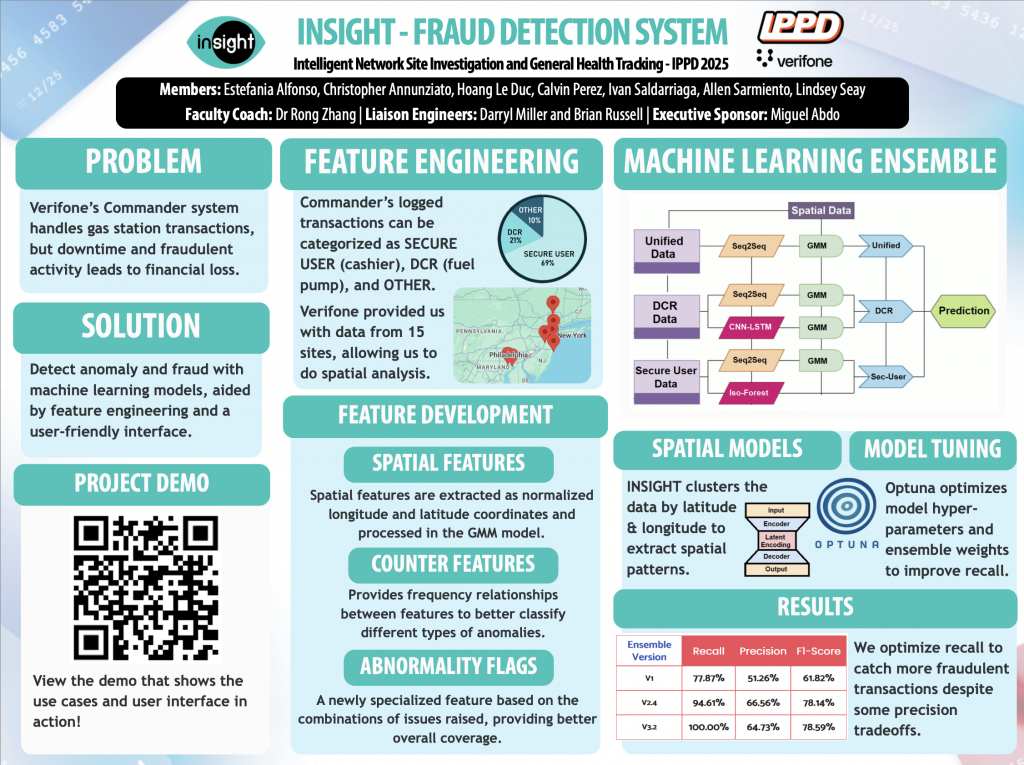
Blog Posts
Week 13 – Gearing Up for FDR
This week, our team has been focused on preparing for our Final Design Review (FDR) presentation, which is quickly approaching. We’ve made significant progress across several key areas and are working hard to ensure everything is ready to go. One of our main accomplishments was collaborating to complete the draft of our project poster. We spent time refining the design, content, and layout to make sure it clearly communicates our project’s goals, technical components, and results so far.
On Tuesday, we presented our FDR draft as a team. This dry run gave us a valuable opportunity to practice our delivery, receive feedback, and fine-tune both the content and timing of our presentation. We also finalized a draft version of our project video, incorporating helpful feedback from our liaison engineer to improve both the clarity and technical accuracy of the visuals and narration. Alongside these milestones, we’ve been continuing to work on our deliverables and documentation to make sure everything is organized and thorough ahead of next week.

Looking ahead, our focus for next week will be to complete the full FDR document as a team. We’ll also finish any remaining documentation, review final materials, and continue practicing for the presentation. With the FDR just around the corner, we’re feeling the pressure—but also the excitement—to showcase everything we’ve accomplished this semester.
Week 12: Presenting at the Cade Museum
This week was a major highlight for Team INSIGHT as we had the honor of presenting our project at the Cade Museum Annex. Presenting in front of a live audience was both nerve-wracking and exciting, but it gave us a chance to share the vision behind our system, demonstrate what we’ve accomplished so far, and connect with others beyond the classroom. The experience was a great opportunity to reflect on how far we’ve come and to receive valuable feedback from attendees.
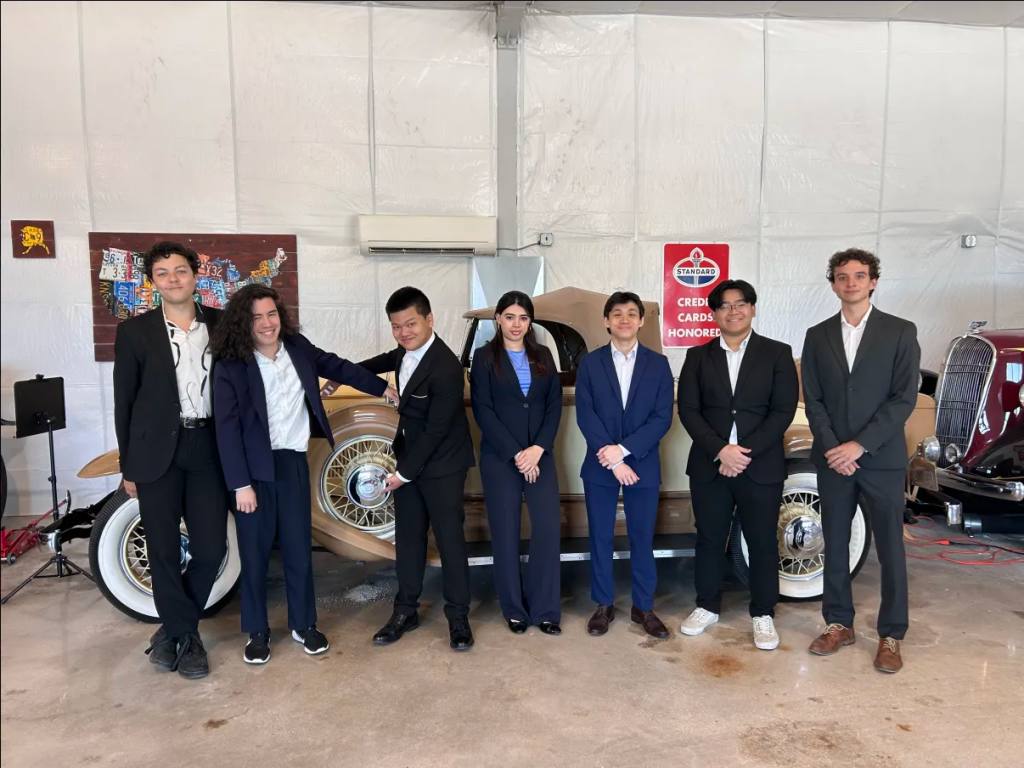
Leading up to the presentation, the entire team worked hard to ensure everything was polished and ready. The UI team filmed and edited a professional promotional video that highlighted the core functions of our system. The FE team completed all feature testing, helping us move into the final stages with confidence. The ML team made key updates to our model pipeline, integrating the latest improvements for better accuracy and performance. We also finalized a strong draft of our project poster, which helped visually communicate our goals, process, and outcomes during the event.
Looking ahead, our focus is on wrapping up the project with the same level of quality and attention to detail. Next week, we plan to complete the FDR (Final Design Review) documentation across Volumes 1 through 4. We’ll also conduct a mock FDR presentation to prepare for the final review. The UI team will revise the video and poster based on peer feedback, and we’ll finalize system-wide testing to ensure everything is functioning as intended. We’re in the home stretch, and the momentum from this week’s presentation is carrying us forward!
Week 11: Focused on PID
This week, our team was primarily focused on finalizing our PowerPoint and practicing our presentation leading up to Prototype Inspection Day (PID) on Tuesday. When prepping for our last major presentation, QRB2, we realized that an incredibly time-effective way to prepare is recording a run-through of our presentation and sending it with our coach, Dr. Zhang, to review and give us feedback, so we replicated that process for PID, and saw great results! We received a solid mix of positive feedback and constructive criticism, most of the latter specifically related to our presentation of our Machine Learning Model Architecture, which we plan to improve for the future.
On a related note, we are excited to share that this Wednesday, it was announced that Team INSIGHT has been given the honor of placing in the top-3 PID presentations by Likert score, and has been invited to present our work next week, as members of the IPPD delegation, at the Cade Museum during the Gainesville Chamber of Commerce’s (GCC) Community Interest Meeting. Professor Latorre has emphasized the importance of this event, saying that GCC invited IPPD to present to promote potential benefits of investing in Alachua County, so we have already started preparing for this great opportunity.
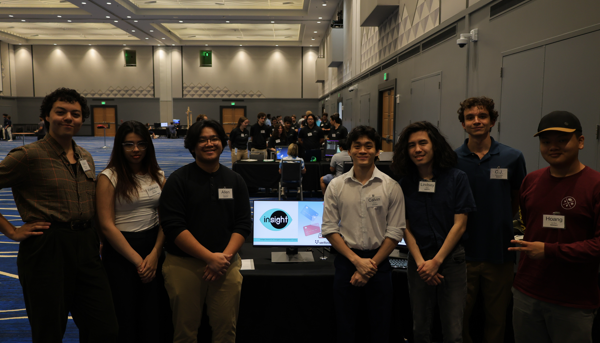
While we were primarily focused on coursework and presentations this week, we also made some progress on the Feature Engineering (FE) and Machine Learning (ML) portions of our project. The FE team completed further testing and began the final phase of feature testing, while the ML team investigated some suspicious activity that was identified when comparing the performance of some of our models with the models of last year’s team.
Going into the coming week, we are excited to present at the Cade Museum and finish all coding portions of the project, so we can shift our focus to finalizing our report and working on project documentation.
Goodbye – more updates to come!
Week 10: Integration & Optimization
This week marked significant progress across all teams as we worked towards refining our system and enhancing performance. With key milestones reached in system integration, feature testing, and model optimization, we are steadily moving closer to a fully functional anomaly detection system for gas station transactions.
The UI Team successfully completed system integration, ensuring seamless interaction between the pipeline and server. This achievement is a crucial step in making our solution operational. Additionally, the team created a short demo video for the PID, showcasing how our system works and its potential impact. This will help communicate our progress effectively to stakeholders.

On the FE side, the team made substantial improvements by reintroducing and testing features, achieving an average 10% increase in recall and precision. This enhancement strengthens our system’s ability to detect anomalies accurately. They also finalized the feature list for previously unidentified anomaly types, allowing for more comprehensive fraud detection. Collaborating closely with the ML Team, they worked on refining the ensemble prediction model to boost overall performance.
The ML Team achieved a major milestone by completing the pipeline and running the first round of Optuna tests, yielding 90%+ recall values for all models. These results indicate strong detection capabilities, setting a solid foundation for further refinement. The team also completed the simulation process, which allows us to better assess real-world performance.
Looking ahead to next week, our primary focus will be completing the FDR report and PID on Tuesday. Each subteam has clear objectives: the UI Team will finalize system integration testing, the FE Team will complete final feature testing and further enhancements, and the ML Team will update the production pipeline with optimized parameters, continue Optuna tests, and begin working on Docker containers and documentation.
With these next steps, we are refining our system for optimal performance and preparing for deployment. We’re excited about the progress made so far and look forward to seeing our final refinements take shape.
Thanks for following our journey—stay tuned for more updates next week!
Week 9: Progress and Spring Break Ahead!
This week, our team made significant strides across various areas of the project. The Front-End (FE) team continued to collaborate closely with the Machine Learning (ML) team to finish the testing of the DCR features, ensuring that everything is running smoothly. Additionally, the FE team focused on developing and testing new features related to the latest anomaly types, which is a major step forward in improving our system’s capabilities.
On the Machine Learning side, the ML team successfully managed to run ensemble predictions locally with batches, bringing us closer to achieving our desired outcomes. This accomplishment has set the stage for more robust and efficient prediction capabilities in the future.
Meanwhile, the User Interface (UI) team worked on creating a promotional video draft that will help showcase the progress we’ve made. They also completed the implementation of the WebSocket and file change detection, both of which are now ready for system integration. These advancements will greatly enhance the interactivity and responsiveness of the system.
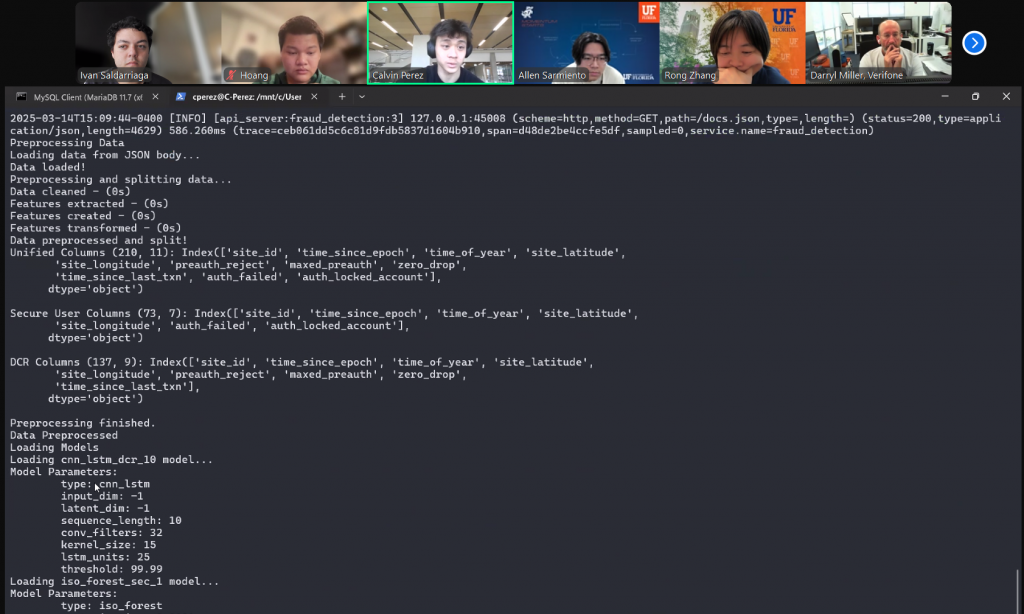
Looking ahead, next week brings some much-needed rest with Spring Break. It’s the perfect time to recharge and prepare for the next phase of the project. I’m excited about the progress we’ve made so far and can’t wait to continue pushing forward when we return!
Goodbye for now, and I hope everyone enjoys a restful and productive Spring Break!
Week 8: Focus on FDR
This week, our team made significant strides in working on the FDR documents, a key project component. Collaboration has been a central focus, with everyone contributing their expertise to refine and enhance our team approach.
The Feature Engineering (FE) team played a pivotal role in testing and retraining the model by reintroducing previously eliminated features. This was an essential step in assessing the impact of those features on performance, allowing us to make informed decisions about which ones to reintegrate. The close collaboration between the FE and ML teams ensured that our choices were aligned and focused on achieving the best possible outcomes for the project.
On the Machine Learning (ML) side, the team successfully implemented an insight optuna-based weight voting system, which has already shown promising results in improving model accuracy. The ML team also dedicated time to refining the synthetic data, ensuring it was more realistic and practical for training, helping the model better generalize to various input data.
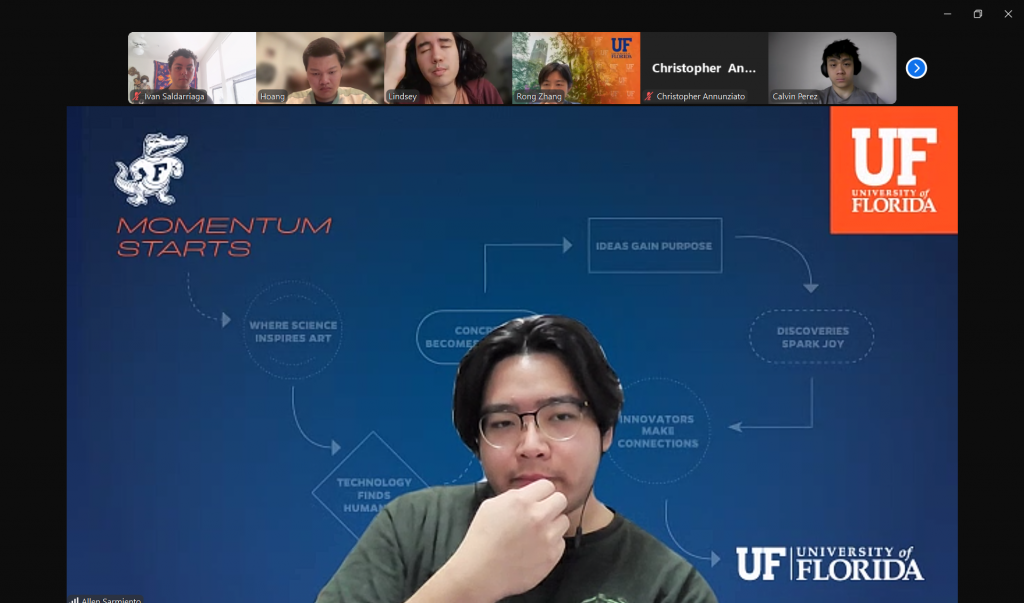
Looking ahead, the next week promises to be just as busy. The UI team will be preparing for usability testing, focusing on gathering user feedback to improve the overall experience. The FE team will continue their work, finishing up the reintroduction of some of the eliminated features based on performance evaluations. The ML team will help with further feature engineering and wrap up the optuna-based work, including writing full pipeline scripts for a smoother workflow.
We’re looking forward to continuing our progress, and we’ll have more updates for you soon.
Goodbye, and see you next week!
Week 7: Strengthening Collaboration and Refining Features
This week, Team INSIGHT focused on collaboration and refinement across all subteams. A major highlight was the collective effort to prepare for the QRB2 presentation and work on the FDR documents, ensuring alignment across different project components.
The QRB2 presentation was a significant milestone for the team, as we worked together extensively to create a well-structured and informative presentation. Unlike QRB1, where we faced challenges in delivering a cohesive message, QRB2 was a more polished and confident performance. We dedicated time to practicing our delivery, refining our talking points, and ensuring each team member was well-prepared to address any questions. This preparation paid off, as QRB2 was far more successful than QRB1, demonstrating our team growth and ability to communicate effectively.
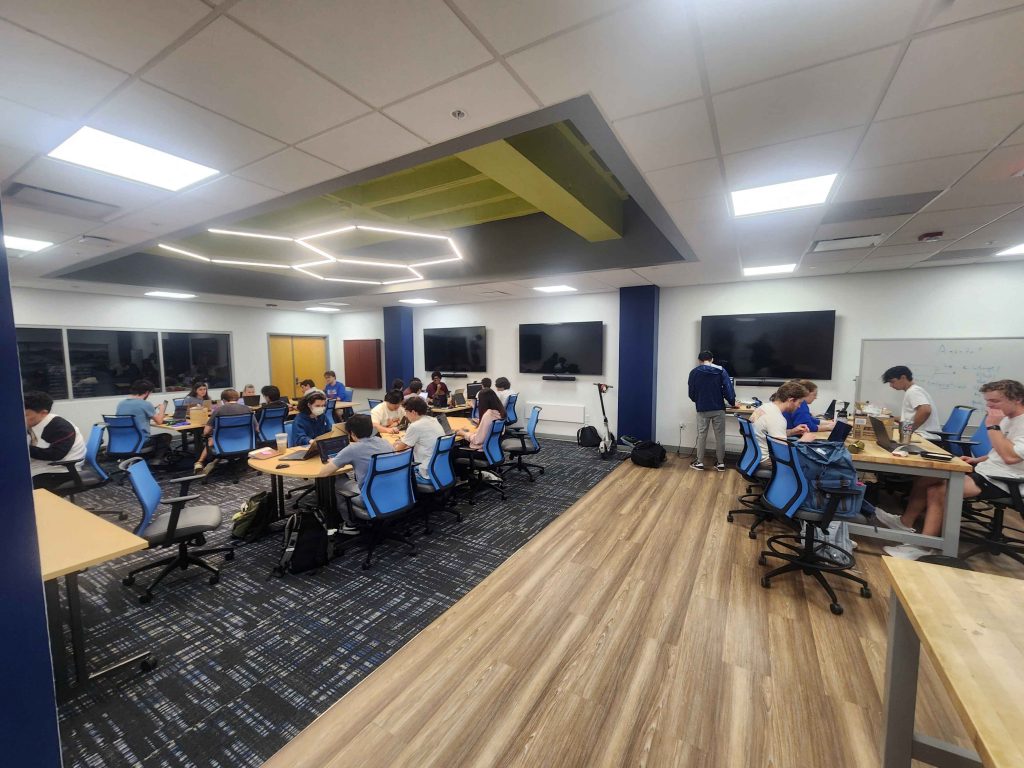
The FE team conducted a thorough assessment of the feature list to verify calculation accuracy, a critical step in ensuring the reliability of our models. Meanwhile, the ML team regenerated synthetic data to enhance testing capabilities and continued evaluating benchmark metrics to gauge model performance effectively.
Looking ahead, next week, we will focus on finalizing the FDR outline. The UI team will continue preparations for usability testing to refine the user experience. Based on performance results, the FE team plans to test and potentially reintroduce some of the eliminated features. The ML team will initiate Optuna testing to fine-tune hyperparameters, further optimizing model accuracy and efficiency.
We are steadily progressing toward our goals with continued teamwork and iterative improvements, and we are looking forward to another productive week—until next time!
Week 6: Key Milestones and Next Steps
This week was highly productive across all subteams, with significant advancements in UI, feature engineering (FE), and machine learning (ML). Each team made progress toward refining and optimizing their respective components, bringing us closer to a more streamlined and efficient system.
The UI team successfully finalized the statistics for the site-specific component, ensuring better visualization and interaction for users. Additionally, the team fully implemented filters, allowing filtering by date and anomaly count. Another notable improvement was the update to marker colors and hover effects based on anomaly count, enhancing the user experience and data interpretation.
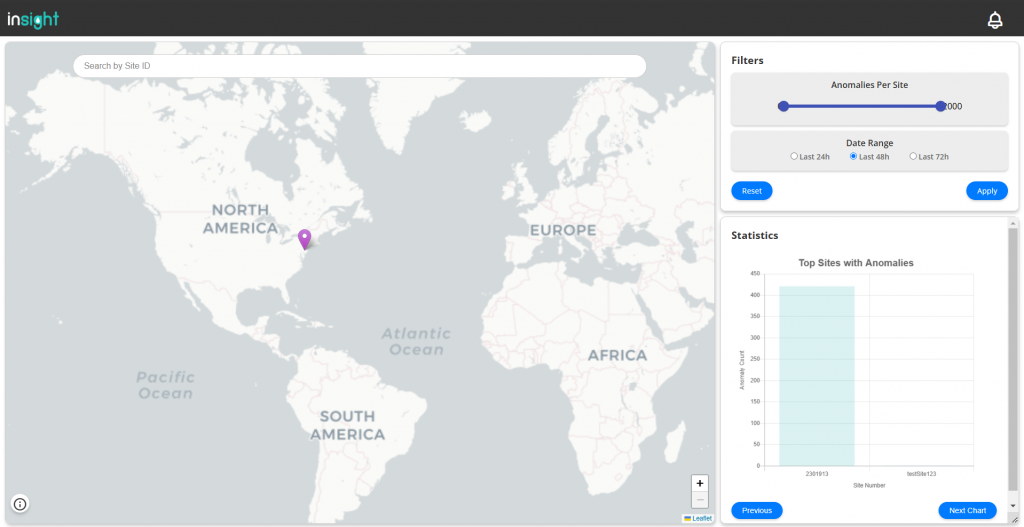
The FE team focused on refining feature selection through correlation analysis, ultimately reducing the number of features to ten for the baseline model. They also conducted rigorous testing on models with and without feature engineering to evaluate their impact on performance.
The ML team made substantial progress by merging the ML pipeline with multisite preprocessing. They finalized both individual and ensemble multisite insight/champs pipelines, ensuring better model integration. The prediction scripts were also updated to accommodate synthetic data, output results to a file, and display relevant model statistics. Additionally, the team trained the seq2seq unified/dcr model, with work on secure_user still in progress.
Looking ahead to next week, the UI team will shift focus to preparing for usability testing, ensuring the latest improvements meet user needs effectively. The FE team plans to test and potentially reintroduce some eliminated features based on performance analysis. Meanwhile, the ML team will focus on Optuna tuning and testing for atomic models and work on integrating the end-to-end ensemble preprocessing and prediction pipeline.
Week by week, we are making great strides in refining our system. Looking forward to another week of progress—until next time!